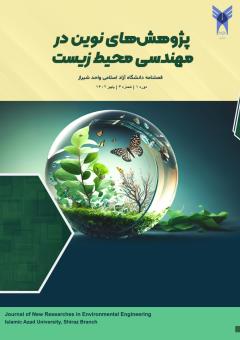درجه بندی غلظت گاز سولفید هیدروژن در اطراف منهول های فاضلابرو به کمک شناساگر استات سرب
محورهای موضوعی : آلودگی های محیط زیست
1 - استادیار، واحد استهبان، دانشگاه آزاد اسلامی، استهبان، ایران
کلید واژه: گازسولفید هیدروژن, بوی نا مطبوع, شبکه فاضلابرو, بوی نامطبوع,
چکیده مقاله :
مقدمه: تولید گاز سولفید هیدروژن ((H2S در شبکههای جمعآوری فاضلاب، مشکلات زیادی شامل خوردگی لولههای بتنی، تأثیر بر سلامتی و بوی نامطبوع ایجاد مینماید. اگرچه شبکه فاضلاب¬رو به شکلی طرح میگردد که هوا در آن جریان داشته باشد و تولید گاز H2S حاصل از فرایند بی¬هوازی شدن در آن اتفاق نیفتد. اما گاهی به علت طراحی نادرست، افزایش دبی، گرفتگی لولهها و یا شکستگی، گاز H2Sاطراف منهولها پراکنده میشود. مانیتورینگ شبکه فاضلاب به کمک تعیین مقدار گاز H2Sمی¬تواند به تعمیر به موقع شبکه کمک مهمی نماید. با توجه به هزینههای بالای سیستمهای مانیتورینگ پیشرفته،کنترل مداوم شبکههای فاضلاب در کشورهای در حال توسعه نیاز به ابداع روشهای ارزان و اقتصادی دارد. هدف از این مقاله ارایه روش ساده رصد کردن گاز H2S به کمک شناساگر تهیه شده از استات سرب، در اطراف منهولهای شبکه فاضلابرو میباشد. مواد و روشها: در این تحقیق با انتخاب 150 منهول در شهر اهواز در ایران و تهیه نوارهای کاغذی آغشته به استات سرب، و همچنین اندازهگیری سرب به کمک گاز سنج قابل حمل مقدار گاز H2S بر اساس رنگ سنجی چشمی مقدار تیرگی ایجاد شده در غلظتهای مختلف درجهبندی شد. سپس با نصب شناساگرها در داخل منهولها و فواصل مختلف از درب منهولها همچنین مدت تماسهای 24 ساعته و یک هفته، بر اساس قابلیت تشخیص گازH2S ، محل مناسب و مدت زمان تماس مناسب تعیین گردید. نتایج و بحث: نتایج نشان داد که اندیکاتورکاغذ استات سرب غلظت گاز H2S از صفر تا 35ppmنشان میدهد. محل مناسب اندازهگیری داخل منهول و بهترین زمان تماس اندیکاتورها نیز 24 ساعت تعیین گردید. نتیجهگیری: انجام مطالعات برای 150 منهول در شهر اهوازنشان داد که استفاده از این روش ساده و اقتصادی میتواند در مانیتورینگ شبکههای فاضلاب در کشورهای کمتر توسعه یافته که امکان استفاده از سنسورهای پیشرفته مانیتورینگ شبکه موجود نیست، مناسب باشد.
Introduction: H2S production in sewage collection networks creates many problems, including corrosion of concrete pipes, effects on human health and unpleasant smells. ). Although the sewerage is designed in such a way that the air flows and the H2S gas production does not occur due to the anaerobic process, but sometimes due to improper design, increase in flow rate, pipe clogging or fracture, the H2S gas disperses around the manholes. Monitoring the sewage network by determining the amount of H2S gas can help network repair in a timely manner. Due to the high cost of advanced monitor systems. The continuous management of sewage networks in developing countries requires the development of cheap and economical methods. Materials and Methods: In this research, 150 manholes were selected in Ahwaz city in Iran. Paper tapes impregnated with lead acetate were prepared. They were placed in different areas around and inside the manholes. After collecting samples, they were classified into seven grades according to the amount of obscuration created in the indicators. At the same points as the samples were taken, the amount of H2S gas was measured by the gas meter. And gas concentration limits were determined for each. Results and Discussion: The results showed that lead acetate paper indicator detected a concentration of H2S from zero to 35ppm. The best positioning of the indicators was within the manholes, and the best contact time was set at 24 hours. Conclusion: It is appropriate to use the results of the ranking of indicators in a situation where it is not possible to use advanced sensors to monitor sewage networks.
References:
Cha JH, Kim DH, Choi SJ, Koo WT, Kim ID.(2018) Sub-Parts-per-Million Hydrogen Sulfide Colorimetric Sensor: Lead Acetate Anchored Nanofibers toward Halitosis Diagnosis. Analytical chemistry, 7;90 (15):8769-8775. doi:10.1021 /acs. analchem. 8b01273
Dehghani,M &Taghizadeh MM.(2013). Designing biological filters to eliminate odors in septic tank based on the amount of hydrogen sulfide Jundishapur J Health Sci 2013 ;5(2):79-87
Dehghani M. Taghizadeh MM. Hashemi H (2013) A Preliminary Assessment of Dispersion Level of SO2 in Fars Industrial Region, South of Iran, by GIS. Journal of Environmental and Public Health 2013(1-2):670590 DOI: 10.1155/2013/670590
Franke W., Frechen F.-B., Giebel S. (2009) H2S, VOC, TOC, electronic noses and odour concentration: use and comparison of different parameters for emission
measurement on air treatment systems.Water Sci Technol 59 (9): 1721-1726.https://doi.org/10.2166/wst.2009.127
Ganigue R., Gutierrez O., Rootsey R.,Yuan Z.,(2011) Chemical dosing for sulfide control in Australia: An industry survey.Water Research. 14(19): 6564-6574https://doi.org/10.1016/j.watres.2011.09.054
Guz L, Łagód G, Jaromin-Gleń K, Suchorab Z, Sobczuk H, and Bieganowski A,(2015) Application of Gas Sensor Arrays in Assessment of Wastewater Purification Effects. Sensors 15, 1-21; doi: 10.3390/s150100001
Jiang G., Keller J.,Bond PL (2014) Determining the long-term effects of H2S concentration, relative humidity and air temperature on concrete sewer corrosion . Water Research 56:157-169 https://doi.org/10.1016/j.watres.2014.07.026
Koe LCC (1985) Ambient hydrogen sulfide levels at a wastewater treatment plant. Environmental Monitoring and Assessment, 5:101–108
Mudragaddam M., Kura B, Iyer A, Ajdari E. (2014) Prediction of CO2and H2S Emissions fromWastewater Wet Wells Journal of Geoscience and Environment Protection, 2,134-142.http://dx.doi.org/10.4236/gep.2014.22019
Okabe, S. M. Odagiri, T. Ito and H. Satoh (2007) Succession of sulfur-oxidizing bacteria in the microbial community on corroding concrete in sewer systems. Applied and Environmental Microbiology 73(3), 971-980.
Priyadharsini M.,Iswarya S.,Chandru S., Alagusundaram K.,(2016) Automatic Monitoring and Blockade Removing in Sewer System Using GPS Tracker. International Journal of Advanced Research in Electrical, Electronics and Instrumentation Engineering. Volume 5, Special Issue 1,111-114
Saeedi A, Najibi A, Mohammadi-Bardbori A (2015) Effects of Long-term Exposure to Hydrogen Sulfide on Human Red Blood Cells. International Journal of Occupational Medicine and Environmental Health 6(1):20-5 DOI:10.15171/ijoem.2015.482


